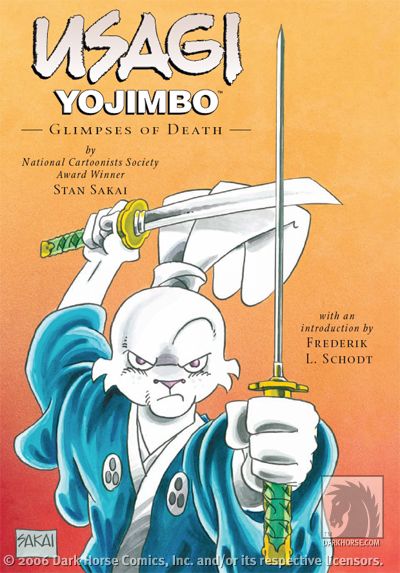Usagi Yojimbo, v. 20: Glimpses of Death
Collects: Usagi Yojimbo #76-82 (2004-5)
Released: July 2006 (Dark Horse)
Format: 192 pages / black and white / $15.95 / ISBN: 9781593075491
 Probably no one would have thought the comic book adventures of an anthropomorphic rabbit samurai would last 20 years when Usagi Yojimbo debuted in Albedo #2 in November 1984.
Probably no one would have thought the comic book adventures of an anthropomorphic rabbit samurai would last 20 years when Usagi Yojimbo debuted in Albedo #2 in November 1984.
Yet here, in 2006, writer / artist / creator Stan Sakai is still going strong, with the series Usagi Yojimbo (literally “rabbit bodyguard”) on its third publisher and nearing its 150th issue. (And that’s not counting the three miniseries starring Sakai’s sci-fi version of the character, Space Usagi.)
Usagi Yojimbo, v. 20: Glimpses of Death continues Usagi’s adventures. No longer traveling with his biological son, Jotaro, Usagi’s adventures are less personal: delivering a token of a faith he doesn’t share, helping an inventor deal with bullies, being bullied by an old woman who feels abandoned by her family, seeing justice done as a vendetta draws to a close. All of Sakai’s Usagi stores are rich in wonderful period and cultural detail, and the trade paperback also includes Sakai’s notes on the sources for his stories.
The final story, which wraps up the saga of Koyama Matabei’s search for his father’s killers, is the only one of the stories that has much of an emotional punch. Koyama and his vendetta first appeared in Usagi Yojimbo #53 (v. 17: Duel at Kitanoji) But this story is an excellent tale of atonement, justice, and vengeance that more than balances the more lightweight tales.
But readers looking for stories about the rabbit may be disappointed. About half the book features stories on other characters who have touched the life of Usagi. In another book, this would appear to be marking time, but since Sakai is the only creator who works on Usagi and he controls Usagi’s schedule, what point is there to waiting around?
Casual readers may not recognize their significance, but long-time readers will be rewarded with looks into the lives of other characters. The most chilling story is that of demon-haunted Inazuma, who breaks free of the control of the demon Jei long enough only to get a dim view of the horror he has put her in. Bounty hunters Gen and Stray Dog renew their rivalry in the pursuit of Inazuma; thankfully, they don’t catch her, but the pursuit isn’t the point. Tomoe deals with a sycophant seeking to replace her in the affections of their lord.
Two other tales involve Sanshobo, a priest, and Inspector Ishida, a detective. Both are enjoyable in and of themselves, which is fortunate, because unlike Tomoe, Gen, and Inazuma, their stories are unlikely to affect Usagi’s. Sanshobo tries to help a troubled priest on the eve of his vows and finds him haunted by an old love; Ishida tries to bring in a troublesome thief but finds himself clearing the thief of a murder he is being made a scapegoat for. The former story is steeped in folklore, the latter in urban legends of a real-life daring Tokyo thief. Both are perfect examples of Sakai’s use of Japanese history and mythology to flesh out his stories, giving them the appearance of being distinctly Japanese and completely original at the same time.
This is another excellent Usagi collection. Although the lack of the title character may put off some, it doesn’t interfere with a great set of stories of feudal Japan (albeit a feudal Japan populated with anthropomorphic animals).
Rating: ![]()
![]()
![]()
![]() (4 of 5)
(4 of 5)
Labels: 4, Dark Horse, Japan, samurai, Stan Sakai, Usagi Yojimbo




0 Comments:
Post a Comment
<< Home